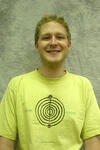Anders Knospe
Measurements by the STAR and PHENIX collaborations indicate that a quark-gluon plasma, a hot and dense state of matter in which quarks and gluons are not confined inside hadrons, is formed in heavy-ion collisions at the Relativistic Heavy Ion Collider. Charm and bottom quarks have been predicted to interact with the medium differently than the light quarks; a study of heavy quark interactions with the medium provides an important test of theoretical models of the quark-gluon plasma.
The spectrum of non-photonic electrons and positrons (e ±) is dominated by e± from the semileptonic decays of D and B mesons. Therefore, non-photonic e± serve as proxies for heavy quarks. A measurement of the modification of the non-photonic e± spectrum in nucleus-nucleus collisions relative to p + p collisions allows the interactions of heavy quarks with the medium to be studied. Previous measurements indicate that high-transverse-momentum non-photonic e± are suppressed in Au + Au collisions at [special characters omitted] = 200 GeV relative to p + p collisions at the same energy. The magnitude of that suppression is larger than was anticipated and it has been a challenge for theoretical models to predict the in-medium energy loss of light and heavy quarks simultaneously.
This dissertation presents the first measurement of the yield of non-photonic e± from open heavy-flavor decays in Cu + Cu collisions at [special characters omitted] = 200 GeV and the suppression of that yield relative to p + p collisions. A comparison of this result to similar results for Au + Au collisions provides some indication that the geometry of a heavy-ion collision affects the average amount of energy loss by heavy quarks passing through the quark-gluon plasma.
